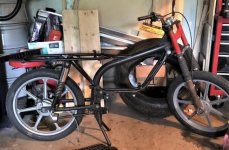evglobal19
100 mW
- Joined
- Apr 3, 2019
- Messages
- 35
So..... I bought one of the 24V bikes more for the look with the idea of building it out/up. I am a novice tinkerer and was thinking about the 48V 1,500 W Rear Hub. I was told the old Heinzmann was fine and the controller was shot. I suppose I could find a generic 36V controller and skip the 'extras' like headlight etc. I'm about 200lb I would think 20-25mph is fast enough on mostly flat city roads. Would prefer electric only with pedals as secondary. Zippy enough to move about any traffic and distance enough for 15 miles before charge. That's the rational side of my brain, safe commuter option. I'll save the Mr. Hyde for another post.
My newbie questions are:
1. is a 1,000, 1,200, or 1,500 W Hub an appropriate choice
2. isn't a 48V better all around than a 36V
3. based on above what amp hour battery makes sense. They go up quickly in $ and the 1,500 'ad' says 48V14aH min. I would probably start with SLA's (I know) if I went blind since cost of Li too high to make mistakes.
4. how do I "know" or where do I look for actual/important specs on an eBay hub motor and controller? amps, Nm, peak, continuous, lots of letters that make little sense to me anyway.
5. Budget I suppose would be about $500; 48V1,500W Hub about $200 and eventually Li battery seems close to $300.
If spend a good time on auto forums so hopefully my placement and etiquette for this question is reasonable. Since this is a build for fun I'm happy to give back in whatever way I can.
Steve
My newbie questions are:
1. is a 1,000, 1,200, or 1,500 W Hub an appropriate choice
2. isn't a 48V better all around than a 36V
3. based on above what amp hour battery makes sense. They go up quickly in $ and the 1,500 'ad' says 48V14aH min. I would probably start with SLA's (I know) if I went blind since cost of Li too high to make mistakes.
4. how do I "know" or where do I look for actual/important specs on an eBay hub motor and controller? amps, Nm, peak, continuous, lots of letters that make little sense to me anyway.
5. Budget I suppose would be about $500; 48V1,500W Hub about $200 and eventually Li battery seems close to $300.
If spend a good time on auto forums so hopefully my placement and etiquette for this question is reasonable. Since this is a build for fun I'm happy to give back in whatever way I can.
Steve




